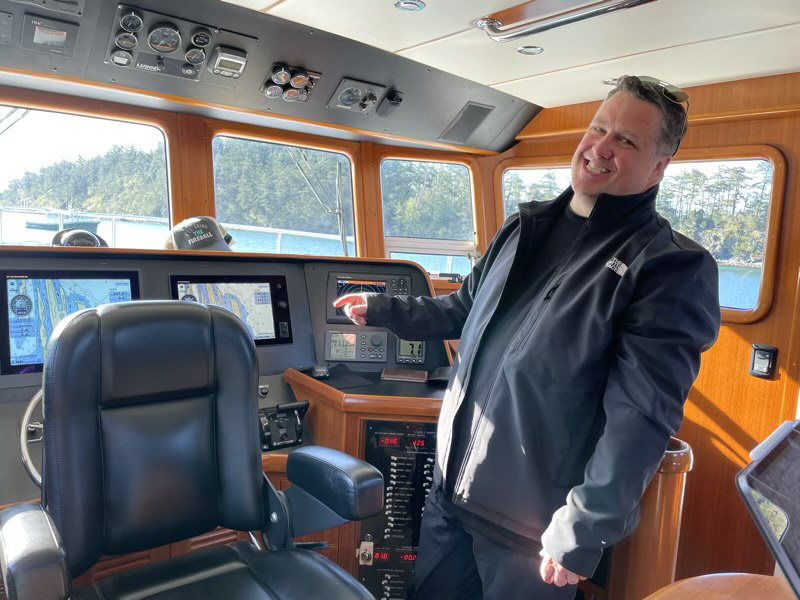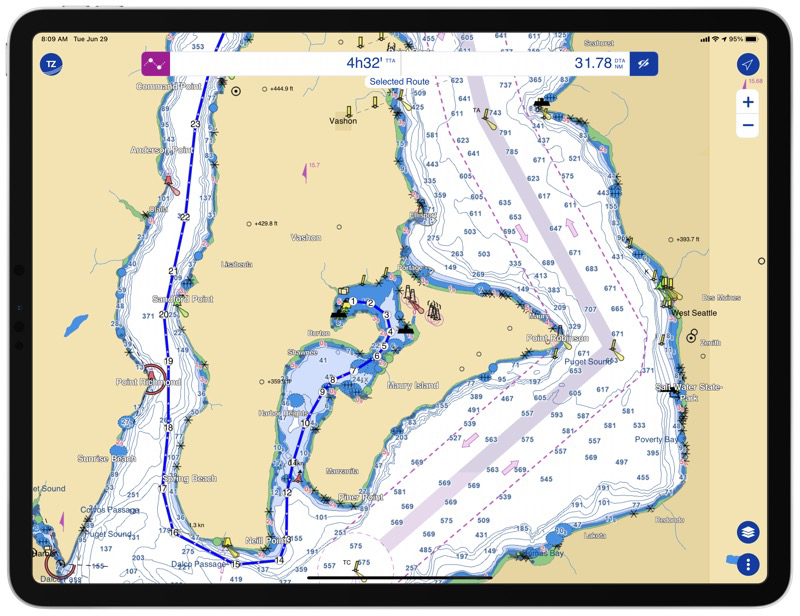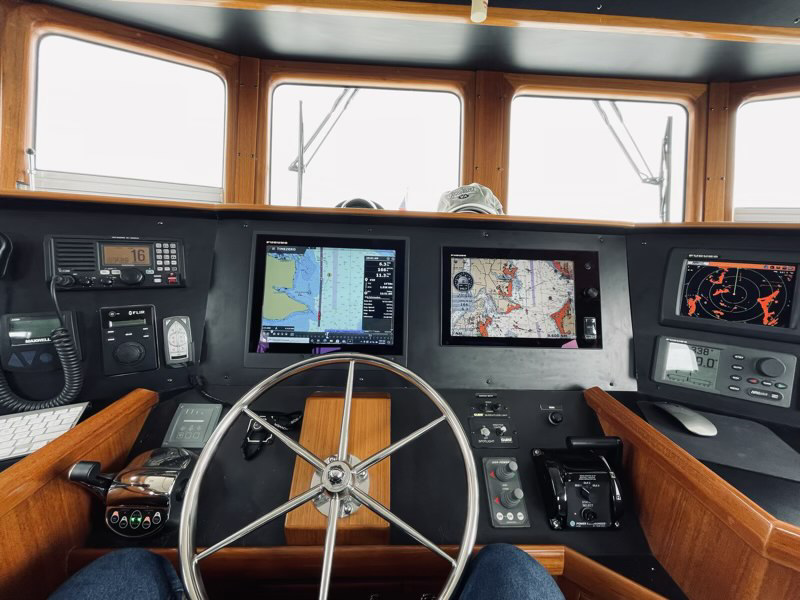With most of my nautical life spent on sailboats, marine electronics has never been much of a focus area. Our most well-equipped cruising sailboat carried just basic navigation equipment: an autopilot, a chartplotter, and instruments for speed, depth, and wind. I knew that more sophisticated systems were available; I just didn’t see the need for anything more complex, though radar would have been a welcome addition with all the fog we have here in the summer.
Indiscretion has navigation instruments and electronics that are far more advanced than any of our sailboats. Besides the basics, we have an open array radar with a satellite compass that overlays radar images right on the chart. We have an NMEA 2000 network running throughout the boat that tracks all sorts of information when we’re underway or at anchor. A Maretron monitoring system tells us, for example, how much fuel and water sit in our tanks, the angle of our rudder, the temperature of the sea, and how far we’ve drifted from our anchor — all from a computer screen in the pilothouse. In our three years aboard the trawler, I haven’t felt the need to add much to our electronics suite. A compass, an open view of the water ahead, and a good chart felt like all I needed.
That is until I spent some time this spring buddy boating with marine technical wizard Steve Mitchell. Besides being a super nice guy, Steve knows more about boat electronics than anyone I’ve ever met, and he freely shares his expertise on his blog, SeaBits.com. If you have any interest in marine electronics, especially getting internet on a boat, have a look at this wonderful resource.
Steve has equipped his beautiful Ocean Alexander with practically every electronic tool you can imagine. He gave me a boat tour of Rendezvous when we shared a dock at Fossil Bay on Sucia Island. While Steve pointed out all the myriad screens and panels from his helm station, I felt a little dizzy. So much information. So many gadgets! He showed me his navigation software, TimeZero Professional, and screen after screen of critical navigation information. My head hurt a little after trying to understand it all.
I invited Steve aboard Indiscretion for a tour of our pilothouse the next day. He took in our instrument panel like a veteran quarterback scanning down field for an open receiver. In a few minutes, he was flipping through never-before-seen setup screens on our Furuno TZ Touch chartplotter and our Furuno NavNet MFD 12. He poked button combinations on our Furuno autopilot that I didn’t know were possible. He turned back to the chartplotter.
“I don’t see any saved routes here. How do you navigate from place to place?”
“Oh, I just use the autopilot and spin that little course change dial,” I said.
Steve studied my face for a moment to make sure I wasn’t joking, then shook his head. “You should enter your route into the chartplotter and let it steer your autopilot for you. That way, you aren’t constantly changing course, and you can keep a better watch for logs and other boats.”
“This chartplotter can talk to that autopilot?” I asked. The possibilities bloomed in my imagination. I could sit back like Captain Kirk and hand off navigation duties to Ensign Furuno.
After a few more minutes of poking around, Steve gave me his verdict. “You’ve got a good set of navigation equipment that will work well with modern electronics, but the brain of your system,” he said, pointing at the NavNet MFD, “is beyond obsolete. You’re probably due to replace both Furuno MFDs and the TZT Touch with current models.”
I swallowed. That sounded expensive.
“Or you could just get a NUC and run TimeZero,” he offered. “That’s probably what I would do.”

After Steve’s visit aboard Indiscretion, I found myself dreaming about the boat steering herself for long passages while I sat back in the captain’s chair, gazing at the sea ahead and taking note of the many wondrous sights in the ship’s log. I tallied the cost of replacing our older NavNet 3D units with the current generation of Furuno chartplotters to modernize our pilothouse and flybridge navigation systems. The total cost, including an estimate for professional installation, would run close to $20,000.
I researched Nobeltec’s TimeZero navigation software, which runs on a Windows PC (no Mac version) and can interface with most modern marine navigation equipment. After reading and rereading online features and capabilities, what I saw during my tour aboard Rendezvous began to make more sense.
I discovered that a NUC is a tiny Windows PC made by Intel that many trawler owners use to run TimeZero. They are popular because of their small size, impressive performance, low power needs, and relatively low cost. NUCs also appeal to the DIY crowd because swapping memory and storage is dead simple.
Fate and good karma conspired a month later when I won a raffle prize of a free license of TimeZero Navigator at the 2021 Nordhavn Rendezvous (thank you, Nobeltec and all the event sponsors!).
That settled it: Indiscretion would get a second brain.
Shopping Spree and Installation
I purchased the latest generation NUC with an Intel i5 processor for about $500. Another $150 for a 500 GB SSD hard drive and 16 GB of RAM, and I had a versatile onboard PC that would run any software I might need on the boat. I picked up a DC converter on Amazon to use 12V to power the NUC to minimize battery drain. I rounded out the setup with a wireless keyboard and mouse.
Next, I spent $1,000 to upgrade my free copy of TimeZero Navigator to the Professional version. Typically, a recreational boater wouldn’t need this extra functionality, but in our case, I could upgrade to ultimate navigation software for $1,000 or pay $500 to unlock the module to connect TZ Navigator to our Furuno system (Professional comes unlocked). I went big.
Indiscretion has a 15” marine-grade Furuno monitor in the pilothouse that provides an easy-to-see screen even in direct sunlight and dims automatically to preserve your night vision during nighttime passages. We use this monitor for our Maretron system and a variety of cameras on the boat. I connected the NUC to its last remaining video port, eliminating the need for another screen on the pilothouse dash.
A week later, the boxes arrived with the computer and its innards. The TZ Professional software license codes sat waiting for me in my email inbox. All I had to do was set it up. I installed the hard drive and RAM modules in mere minutes. That was easy. But when I powered up the NUC, I learned that Windows wasn’t installed. Uh oh. I would need to download the Windows installer program on another Windows computer. Ugh. This is why I use a Mac.
Luckily, I keep a cheap HP laptop in a drawer on the boat for updating our Maretron monitoring system. I used it to download Windows 10 onto a thumb drive and, after deciphering some cryptic installer options, had Windows 10 Professional running successfully on the NUC.
Next, I installed TimeZero Professional and then all my charts. Another benefit of going with the Professional version is that the charts I bought for our existing Furuno NavNet system transfer over free.
Then, the moment of truth. Would this NUC and TimeZero software connect to my Furuno navigation instruments and radar? I powered the Furuno gear up, plugged in the NUC to our NavNet network using an ethernet cable, and ran the connection wizard in TimeZero.
After some initial failures, I received navigation data in TimeZero, but no matter how many configurations I tried, I could not get TimeZero to send steering commands to our Furuno autopilot. I spent a long weekend searching Furuno and TimeZero forums and tinkering with settings unsuccessfully.
I called TimeZero technical support on Monday for assistance. A friendly support technician named Lucas picked up on the second ring, and I described my problem.
“Ah, yes,” he said. “You can’t connect to your old equipment using ethernet. You need an Actisense NGT-1 USB cable, so you can connect directly to your NMEA 2000 network.”
I found the $240 cable on defender.com and a $20 T-Connector to patch into the boat’s network backbone.
A week later, the cable arrived, and I installed it in place of the ethernet cable. I ran the TimeZero connection wizard. Still, no luck.
I called TimeZero support again. Lucas answered on the first ring. He started asking questions about network settings and whether TimeZero was connected to the NMEA network. My uncertain replies must have been a clue that I didn’t really know what I was talking about. “Do you have boat internet?” He asked.
“Yes, I do.” Finally, a question could answer.
“OK, great. Let me take over your TimeZero system, and we’ll figure this out.”
In a few moments, Lucas had full control over my system. I watched as screens quickly appeared and vanished as we chatted.
“Yeah, so you aren’t connected to your NMEA 2000 network. Did you install the drivers for the Actisense cable?”
“Uh …” I stammered.
“No worries. I can do that from here. Also, the firmware on the cable needs to be updated to work with the latest version of our software.”
After a few minutes, Lucas had the drivers and latest firmware installed. He ran the connection wizard in Time Zero again, and this time the software connected to the NMEA 2000 network. A simple checkbox near the end of the connection process integrated the autopilot. Another click added TimeZero’s cloud service for my iPad. The system was now fully integrated and operational, thanks to terrific technical support from TimeZero.
Navigating with TimeZero Professional
We had a chance to put Indiscretion’s new navigation system to work on a cruise to the San Juan Islands last week.
The night before departure, I built the route for our first leg of the trip: Quartermaster Harbor to Port Ludlow. I plotted the course from my easy chair at home using TZ iBoat on my iPad. The iPad app lacks much of the functionality of the desktop software, but the touch interface for plotting a course is terrific.

The next morning, I powered up our navigation equipment and the new TimeZero system as the engine warmed up. The route I created the night before on the iPad appeared as if by magic, ready to activate on the pilothouse screen.
TimeZero provides an estimate of the best time to cast off using a route optimization routine. Currents can run pretty strong in Puget Sound and the northern islands, so planning your trip around them is critical, especially on a slow boat like a trawler. Before this, we cobbled together a few different tide and current apps to make our best guess on when to leave. TimeZero turns this into a more exact science, providing a departure time to the minute to minimize your voyage time.
As we left the marina and steamed out of Inner Quartermaster Marina, I activated our chosen route and turned the helm over to TimeZero. The route transformed into a highway shape with an icon for Indiscretion chugging down it. I sat back in the helm chair and watched the magic unfold. Waypoints arrived and passed astern, with the autopilot responding perfectly for each course change. Instead of focusing on our course, I could simply watch for boat traffic and obstructions in the water. Other than diverting for commercial traffic and a few logs, I rarely interfered with the helm. On the five-hour trip, TimeZero steered 99.5% of the time without needing a single coffee break.

A Smart Investment
Between the NUC PC, TimeZero software, and the ActiSense cable, I spent about $2,000 to equip Indiscretion with this new navigation setup. This a terrific bargain considering these benefits:
Two Are Better Than One. Before this, I relied exclusively on the 14” TZ Touch chartplotter for navigation. That worked fine, but having two independent navigation screens directly in front of the helm is much better. The TimeZero screen shows our route, radar overlay, AIS targets and closest points of approach, and time and distance left on our trip. I use the chartplotter screen for all other chart-related information. I can zoom out and pan forward to check the waterways ahead while keeping tabs on our current course at a zoomed-in level on the left. Or, I can zoom in to a much finer detail on the chartplotter to check charted depths, again without disrupting my view of our current voyage. Both screens show similar information, but I can tailor the views to fit any navigational need I might have.
The Power of the Cloud. TimeZero connects wirelessly to the internet for chart and weather updates and extends the reach of AIS by incorporating vessel tracking via MarineTraffic.com. For me, the ability to plan a route on my iPad in the salon as Lisa and I discuss our next destination and have that route ready to activate from the pilothouse is a killer feature.
Potential for Future Expansion. This NUC computer has the horsepower to run more than just TimeZero Professional. We need to update our Maretron MBB200C “black box” computer, which runs our vessel monitoring system. This unit is seven years old and can no longer run the current version of Maretron’s N2KView software. A quick call to Maretron support confirmed that the diminutive NUC could take over that function for us, saving us $1,500 in computer replacement and the power drain of running two separate pilothouse computers.
I’ve just scratched the surface of the capabilities of TimeZero Professional, but it’s already become an essential part of our navigation. This new setup has added a ton of new life into the boat’s aging electronics, which will allow me to defer this $20,000 replacement of those expensive chartplotters for at least another year. When I do buy new units, this NUC/TimeZero system will still provide all the benefits of a second navigation brain for the boat.
While spending money on a boat rarely provides a return, I can already tell that this particular setup will pay dividends for years to come.

Great read. Love the technical side of boating so this was very interesting to read and not a side of boating I see often in blogs or vlogs so thank you for the write up!
Great article. Thank you for sharing. Which 12v supply did you buy? Please update us down the line on performance! Have a great one. William.
Hi William – Thanks for your note and question. I wasn’t able to find a plug-and-play 12V power supply for the NUC though I would have bought one in a heartbeat. Instead, I bought a step up converter from Amazon to wire the boat’s 12V system to the NUC’s 19V power supply. Right now I’ve plugged the NUC into a 110 outlet since we’re only using it for navigation when we’re underway and power drain isn’t an issue. I’ll hard-wire the converter once I cut over from our Maretron black box computer to the NUC for 24/7 vessel monitoring. Here’s the link of the converter I purchased:
https://www.amazon.com/gp/product/B089LS93HM/ref=ppx_yo_dt_b_search_asin_title?ie=UTF8&psc=1